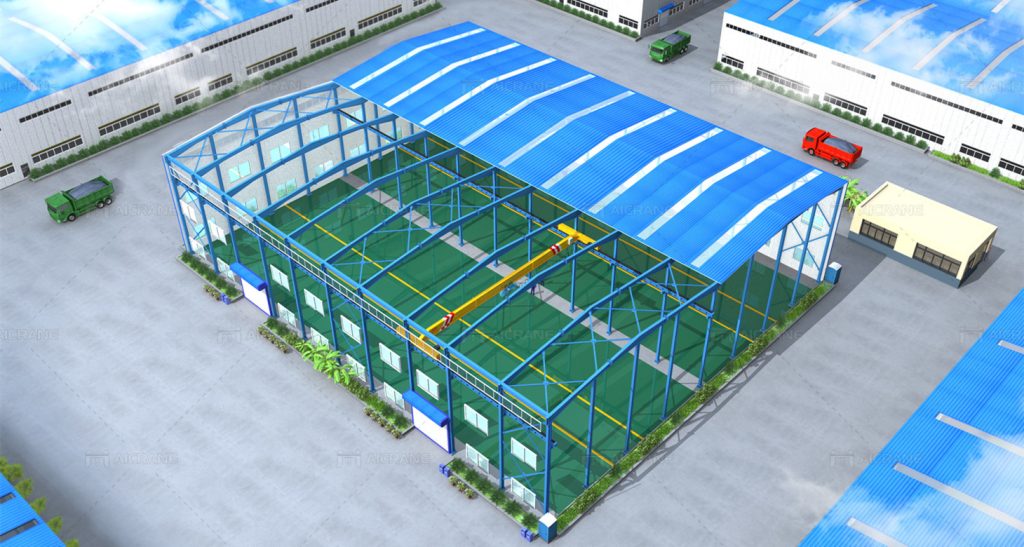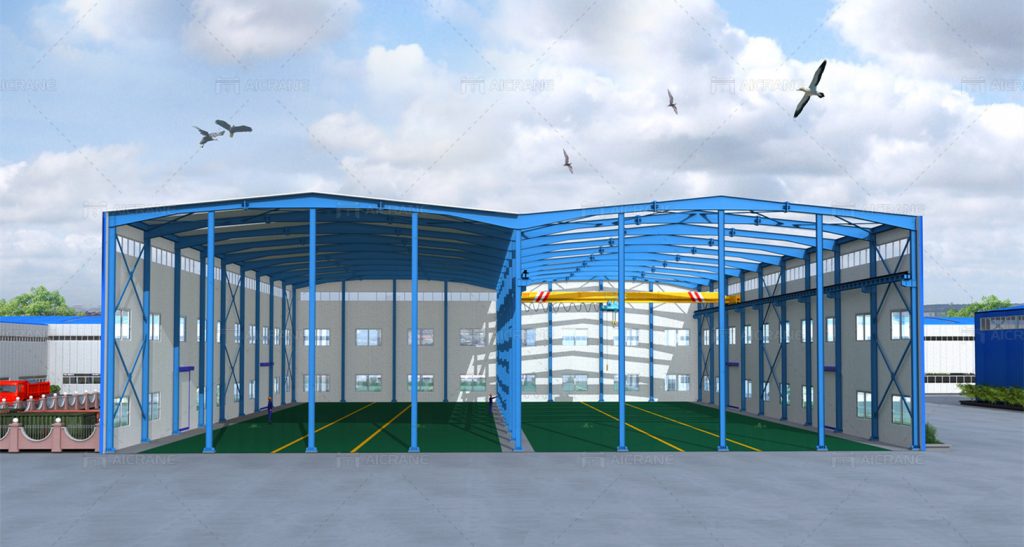Steel structure warehouses have become increasingly popular in various industries due to their durability, flexibility, and cost-effectiveness. These structures are designed to withstand harsh environmental conditions and heavy usage, making them an ideal choice for storage and industrial operations. However, like any building, steel structure warehouses require regular maintenance to ensure their longevity and optimal performance. Proper maintenance not only extends the life of the warehouse but also ensures the safety of the goods stored within. In this passage, we will discuss essential tips for maintaining a steel structure warehouse.

Regular Inspections
The first step in maintaining a steel structure warehouse is conducting regular inspections. These inspections should be thorough and cover all aspects of the structure, including the roof, walls, foundation, and internal components.
a. Structural Integrity: Inspect the warehouse’s structural integrity by checking for any signs of rust, corrosion, or damage to the steel components. Pay special attention to areas that are exposed to moisture, as these are more prone to rust. If any damage is detected, it should be addressed immediately to prevent further deterioration.
b. Roof Inspections: The roof is a critical part of the warehouse, as it protects the interior from the elements. Regularly inspect the roof for leaks, missing or damaged panels, and any signs of wear and tear. Ensure that the roof drainage system is functioning properly to prevent water accumulation, which can lead to rust and structural damage.
c. Foundation Checks: The foundation supports the entire structure, so it’s important to check for cracks, settling, or other issues that could compromise the warehouse’s stability. Any foundation problems should be repaired by a professional to ensure the long-term safety of the building.
Corrosion Prevention and Treatment
Corrosion is one of the biggest threats to the longevity of a steel structure workshop and warehouse. Preventing and treating corrosion is essential to maintaining the warehouse’s structural integrity.
a. Protective Coatings: Applying protective coatings, such as paint or galvanization, to the steel components can help prevent rust and corrosion. These coatings act as a barrier between the steel and the elements, reducing the risk of damage. It’s important to choose the right type of coating based on the environmental conditions the warehouse is exposed to.
b. Regular Cleaning: Dirt, dust, and debris can accumulate on steel surfaces, trapping moisture and leading to corrosion. Regular cleaning of the warehouse’s exterior and interior steel components can prevent this buildup and reduce the risk of rust. Use appropriate cleaning agents that won’t damage the protective coatings or the steel itself.
c. Corrosion Treatment: If corrosion is detected during inspections, it should be treated immediately. This may involve removing the rust with wire brushes or sandblasting and then applying a rust-inhibiting primer and protective coating. For severe cases, it may be necessary to replace the affected steel components to ensure the warehouse’s safety.
Roof and Wall Maintenance
The roof and walls of a steel structure warehouse play a crucial role in protecting the interior from environmental factors. Proper maintenance of these components is essential for the overall health of the warehouse.
a. Roof Panel Replacement: Over time, roof panels may become damaged due to weather conditions or wear and tear. Promptly replace any damaged panels to prevent leaks and further structural issues. Ensure that the replacement panels are properly installed and sealed to maintain the integrity of the roof.
b. Wall Inspections and Repairs: Similar to the roof, the walls of the warehouse should be inspected regularly for any signs of damage or wear. Look for gaps, cracks, or loose panels that could allow moisture or pests to enter the warehouse. Repair any issues promptly to maintain the building’s insulation and protect the goods stored inside.
c. Gutter and Drainage System Maintenance: The gutter and drainage systems are responsible for directing water away from the roof and walls. Regularly clean the gutters to prevent blockages, and ensure that the downspouts are clear and functioning properly. A well-maintained drainage system helps prevent water damage to the warehouse’s structure.

Ventilation and Insulation Maintenance
Proper ventilation and insulation are critical for maintaining a comfortable and safe environment within the steel structure warehouse. These systems help regulate temperature, reduce humidity, and prevent condensation, which can lead to rust and corrosion.
a. Ventilation System Checks: Regularly inspect the warehouse’s ventilation system to ensure it’s functioning properly. Check for any blockages, damaged fans, or malfunctioning components. Adequate ventilation helps prevent the buildup of moisture and condensation, which can damage both the structure and the goods stored inside.
b. Insulation Inspection: Inspect the warehouse’s insulation for any signs of damage, such as tears, gaps, or compression. Damaged insulation can lead to temperature fluctuations and increased energy costs. Repair or replace any damaged insulation to maintain the warehouse’s energy efficiency and protect against condensation.
c. Temperature and Humidity Control: Monitoring and controlling the temperature and humidity levels within the warehouse can prevent issues such as condensation, which can lead to rust and mold growth. Consider installing temperature and humidity sensors to monitor the environment and make adjustments as needed.
Pest Control
Pests can cause significant damage to a steel structure warehouse by nesting in insulation, chewing through electrical wiring, and contaminating stored goods. Implementing a pest control plan is essential to maintaining the integrity of the warehouse.
a. Regular Inspections: Conduct regular inspections for signs of pest activity, such as droppings, nests, or gnawed materials. Pay special attention to entry points, such as gaps around doors, windows, and vents, where pests can enter the building.
b. Sealing Entry Points: Seal any gaps or openings in the warehouse’s structure to prevent pests from entering. This includes caulking around windows, sealing cracks in walls, and installing door sweeps. A well-sealed warehouse is less likely to attract pests.
c. Professional Pest Control: If pests are detected, consider hiring a professional pest control service to address the issue. Regular pest control treatments can prevent infestations and protect the warehouse from damage.
Regular Training for Maintenance Personnel
The effectiveness of a maintenance plan relies heavily on the knowledge and skills of the personnel responsible for carrying it out. Providing regular training for maintenance staff ensures that they are equipped with the latest techniques and best practices for maintaining a steel structure warehouse.
a. Safety Training: Ensure that all maintenance personnel are trained in safety protocols specific to working with steel structures. This includes proper use of personal protective equipment (PPE), safe handling of materials, and awareness of potential hazards.
b. Technical Training: Provide technical training on the specific maintenance tasks required for steel structure warehouses. This includes training on inspection techniques, corrosion prevention methods, and repair procedures. Well-trained personnel are more likely to perform maintenance tasks correctly and efficiently.
c. Ongoing Education: Encourage ongoing education and professional development for maintenance staff. Some manufacturers like Aicrane provide similar services.This can include attending workshops, seminars, or online courses on the latest advancements in steel structure maintenance. Staying updated on industry trends and technologies helps ensure that the warehouse remains in top condition.
Documentation and Record-Keeping
Maintaining detailed records of all maintenance activities is crucial for tracking the condition of the steel structure warehouse and planning future maintenance tasks.
a. Maintenance Logs: Keep a log of all inspections, repairs, and maintenance tasks performed on the warehouse. This log should include the date, description of the work performed, and the personnel involved. A well-maintained log provides a history of the warehouse’s condition and helps identify patterns or recurring issues.
b. Scheduling Future Maintenance: Use the maintenance logs to schedule future inspections and maintenance tasks. Regularly review the logs to identify any areas that may require more frequent attention or additional preventive measures.
c. Compliance with Regulations: Ensure that all maintenance activities comply with local building codes and regulations. Keep records of any inspections or certifications required by law to demonstrate compliance and avoid potential fines or penalties.
Proper maintenance of a steel structure warehouse is essential for ensuring its longevity, safety, and efficiency. By conducting regular inspections, preventing and treating corrosion, maintaining the roof and walls, ensuring proper ventilation and insulation, implementing pest control measures, training maintenance personnel, and keeping detailed records, you can protect your investment and ensure the continued success of your operations. A well-maintained steel structure warehouse not only provides a safe and secure environment for stored goods but also contributes to the overall efficiency and profitability of your business.